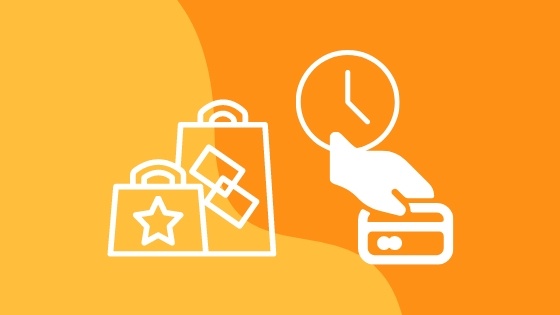 Smart eCommerce retailers are always on the lookout for new and innovative ways to win more conversions. One method that’s seeing a surge in interest is shop now, pay later solutions.
Smart eCommerce retailers are always on the lookout for new and innovative ways to win more conversions. One method that’s seeing a surge in interest is shop now, pay later solutions.
Services like Afterpay and Klarna make it easy for merchants to give customers greater flexibility with payment installment plans. With these and other shop now, pay later platforms, there’s no need for complex code or major changes to your payment infrastructure to set them up. They allow you to complete the sale and receive the resulting revenue as you normally would while they take care of the installation part. But is this type of payment option right for your brand?
We’ll take a closer look at how installment plans work and discuss the pros and cons of shop now, pay later programs to help you decide whether implementing one is the right choice for your online store.
How Shop Now, Pay Later Programs Work
If you’re old enough to remember the days before online shopping ruled the retail world, you probably remember the prevalence of layaway programs.
With layaway, retailers allowed customers to reserve an item and pay for it over time in several equal payments rather than using a credit card and racking up interest. Shop now, pay later programs are the virtual equivalent of layaway, the key difference being that the customer gets to receive the item right away rather than waiting until they’ve paid for it in full.
Most of these programs work by offering the option to select a payment installment plan at checkout. From there, the customer is taken to the app’s interface via a plugin or API call where they’ll complete the remainder of their purchase. The retailer receives the full payment immediately (or close to it, typically within three business days) while the application takes care of processing the installment payments at the agreed-upon time.
You might be wondering, if layaway has been around for decades, why are shop now, pay later plans suddenly seeing a surge in use? With consumer debt on the rise and financial instability mounting for millions of families, shoppers are more wary of using credit cards to finance purchases.
According to Experian, Americans have $784 billion in outstanding credit card debt, with the average debt being around $2,300. More than half of credit card users said the cards they were using were not ideal, with high interest rates being the number one concern.
Payment installment plans offer an alternative to credit, allowing responsible shoppers to pay for a purchase over time without the added burden of interest or dings to their credit score.
Pros of Payment Installment Plans
Increase in conversions. Perhaps the biggest benefit of offering a payment installment plan is that it has the potential to significantly increase your conversion rate. Afterpay, for example, reports that its retailers experience a 22% increase in conversions after adding an installment option to checkout.
Since buy now, pay later apps don’t require the use of credit, there’s little downside for responsible consumers to use them to make purchases more accessible. Thus, they’re less likely to think twice about the cost of their order and abandon their cart.
Increase in average cart size. Consumers also tend to spend more when they don’t have to pay in full right away. This gives retailers the benefit of bigger carts. According to Klarna, its retailers see a 45% increase in average order value after implementing their installment plan. Even a small increase to your average cart size can translate into an exponential boost in revenue.
Convenience. Unlike self-hosted installment plans, which would require you as the retailer to also function as a payment collector, third-party shop now, pay later programs let you get paid in full immediately while they take care of facilitating payment. They integrate with most major eCommerce platforms, like Shopify or WooCommerce, to provide a seamless, branded checkout experience.
Greater customer satisfaction. Customers crave online shopping experiences that are tailored to meet their needs. Especially in the current landscape where many people are under financial uncertainty, offering flexible payment options is just one more way to serve your customers and cement their loyalty to your brand.
Cons of Payment Installment Plans
Account creation may be required. Depending on the installment plan provider you choose, the customer may be required to create an account or fill out a short form before completing checkout. This adds an additional step to the checkout process, which is always something retailers want to try to avoid. However, the resulting boost in conversions may offset any adverse effects of the additional step.
Cost. Payment installment apps come with a cost to the retailer. This is assessed on a per-transaction basis. Klarna charges retailers a flat fee of up to $0.30 per transaction plus 5.99% of the total transaction. Afterpay charges a flat fee of $0.30 plus a percentage of the transaction that ranges from 4% to just over 6%. The higher your sales volume, the lower your transaction fee.
You’ll need to weigh the cost against the potential revenue increase to decide whether it makes sense for your store. For some retailers, like those who operate on very slim margins, the added cost may eat into profits too much to make installment plans a viable sales strategy. Smart Company has a good in-depth breakdown of how to weigh your sales volume and profit margins against the cost of using Afterpay to get a dollars-and-sense assessment of whether it will benefit you.
Discover More Revenue-Boosting eCommerce Strategies with Springbot
Are you taking full advantage of all the tools and tactics available to boost your online store’s revenue? From payment installment plans to email automation to online ad management, Springbot can help you integrate all of your marketing efforts and analyze their results from one user-friendly dashboard. Intuitive features allow you to build campaigns without any coding, while easy-to-read reports help you discover new opportunities to increase margins and win more conversions.
Schedule your free conversation with our team of eCommerce experts to learn how to put Springbot to work for your business today.




